Key takeaways:
- Selective mutism is an anxiety disorder affecting communication in specific situations, leading to isolation and emotional distress.
- Public speaking anxiety involves fear of judgment, which can hinder expression despite adequate preparation and skills.
- Strategies to overcome anxiety include mindfulness, visualization, gradual exposure, and using visual aids during presentations.
- Effective communication requires clarity, active listening, and positive body language to engage the audience and reduce nervousness.
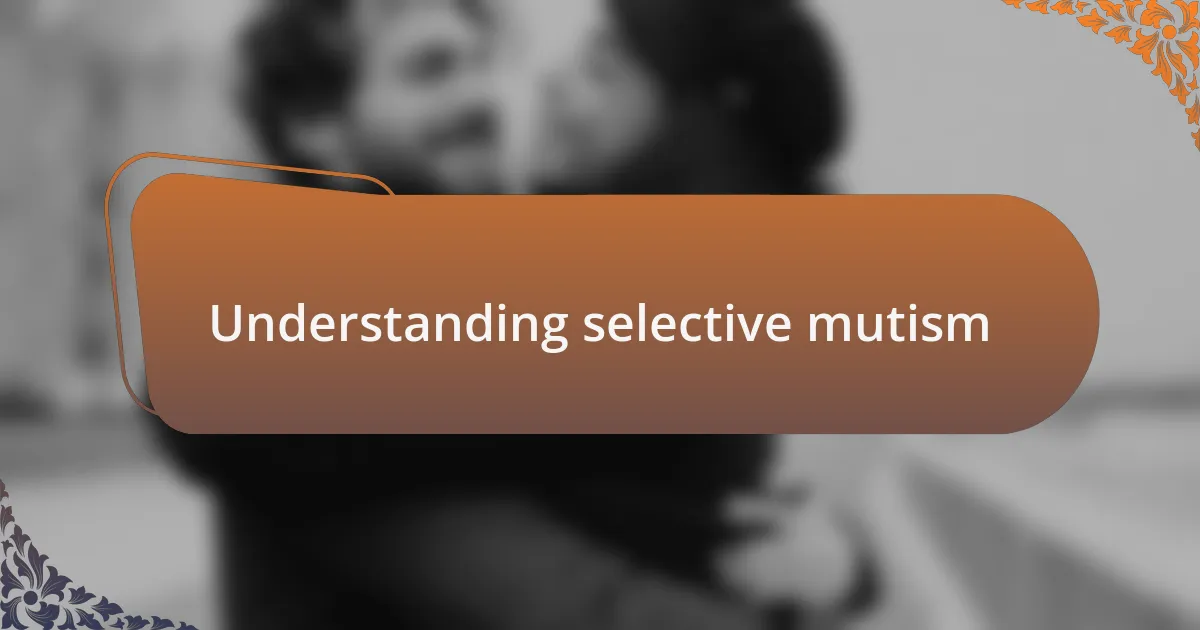
Understanding selective mutism
Selective mutism is often misunderstood, yet it profoundly impacts those who experience it. Imagine being in a room full of people, feeling the weight of words lodged in your throat, unable to voice your thoughts. I remember a friend from school who struggled with this. Despite having a wealth of ideas, they felt paralyzed in social settings, which often led to feelings of isolation and frustration.
At its core, selective mutism is an anxiety disorder primarily seen in children, though it can extend into adulthood. It’s not simply a reluctance to speak; individuals may find themselves unable to communicate in specific situations while being talkative in others. In my experience, this can lead to a terrible conflict between the desire to express oneself and the overwhelming fear of judgment or misunderstanding.
If we pause for a moment to reflect, what does it mean to be silent when you have so much to say? The emotional toll can be significant, leading to low self-esteem and social withdrawal. Understanding selective mutism requires empathy and patience, both for those living with it and those around them.

Impact of selective mutism
Selective mutism has far-reaching effects on social development and emotional well-being. One of the most striking experiences I’ve come across is witnessing a child who excelled academically but struggled to participate in classroom discussions. Can you imagine the frustration? It’s not just about the inability to speak; it’s about missing out on vital social interactions that help shape our identities.
For individuals with selective mutism, the daily grind can feel like climbing a mountain. I remember working with someone who had a wealth of stories to share yet felt trapped in quietude during group activities. This gap can lead to isolation, where one might feel like an observer in their own life, yearning for connection but feeling detached due to overwhelming anxiety.
Emotional scars often linger long after the silence. The anxiety can manifest as self-doubt and fear of negative perception, making it difficult for those affected to build meaningful relationships. I’ve seen people struggle with feelings of inadequacy, often questioning their worth based on their ability to communicate. How do we uplift those voices that remain unheard? It’s essential to foster an environment where everyone feels safe to express themselves, no matter the form it takes.
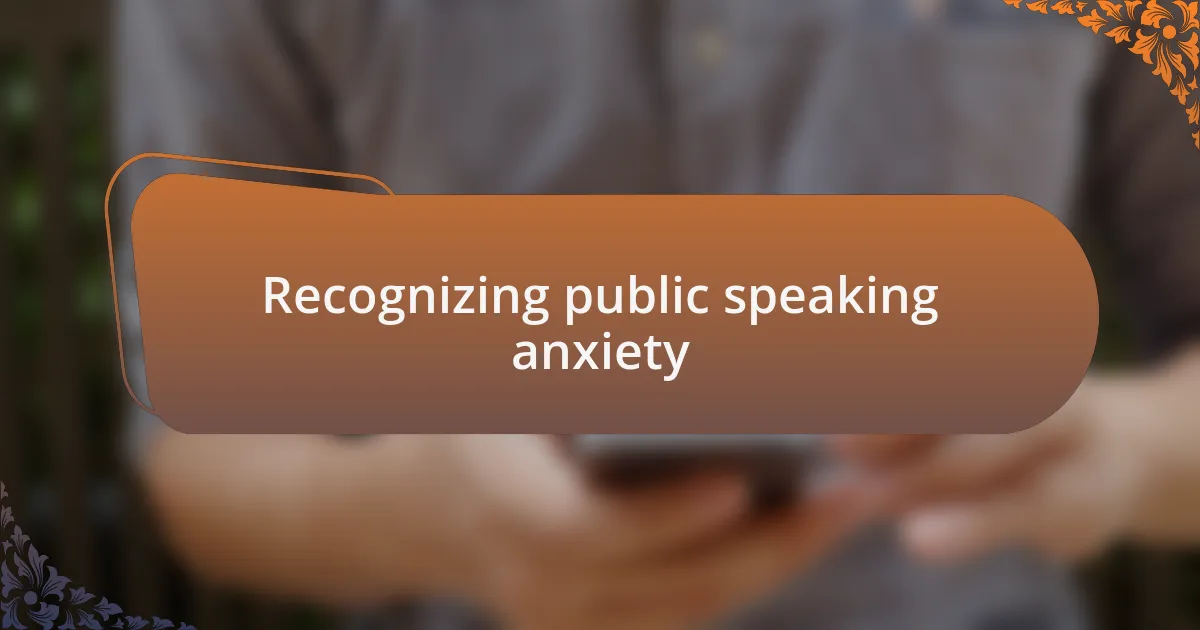
Recognizing public speaking anxiety
Public speaking anxiety often starts with a tightness in the chest or a racing heartbeat, feelings I know all too well. I remember preparing for a presentation in front of my peers; the thought alone made my hands sweat and my stomach turn. It’s curious how the possibility of speaking can morph into a mental block, isn’t it?
For many, the fear of judgment takes center stage. I once coached a young adult who would rehearse in front of the mirror, yet the moment they faced an audience, the words seemed to evaporate. This disconnect reveals how anxiety can warp our perception of reality, making us believe our voices and thoughts are unworthy of being heard.
Yet, recognizing these symptoms is the first step toward addressing them. Have you ever felt that internal debate before speaking up, weighing every word that comes to mind? I’ve often found that acknowledging this anxiety is crucial—after all, it’s a common hurdle, not a personal failing. Understanding that many experience similar feelings can sometimes be the key to overcoming that paralyzing fear.
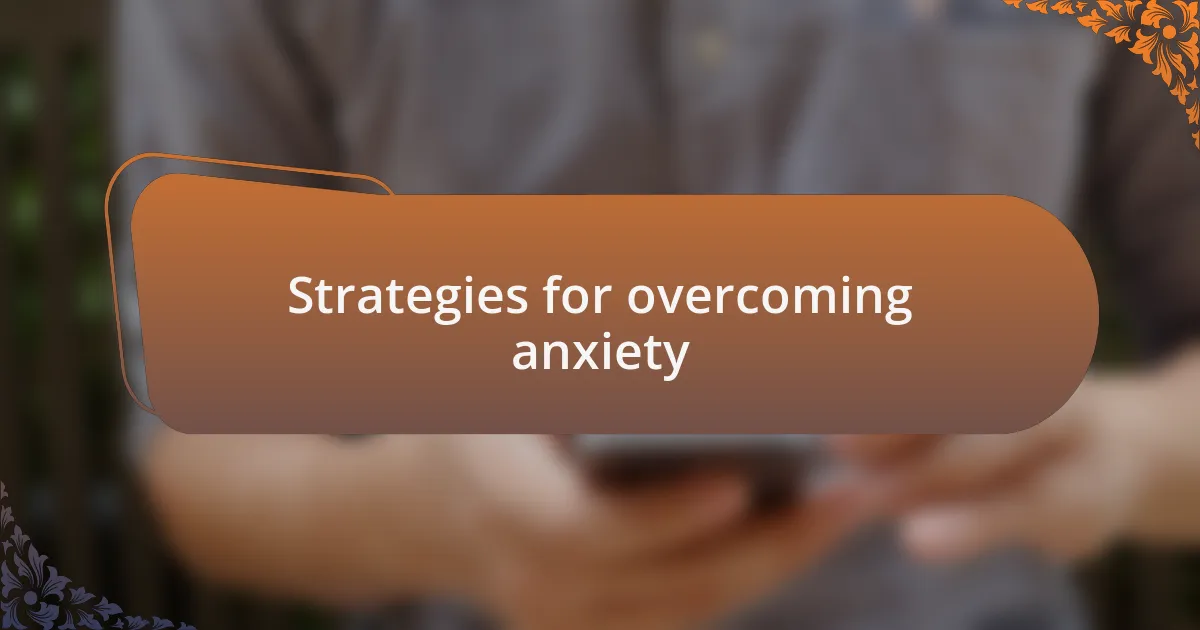
Strategies for overcoming anxiety
One effective strategy I’ve found to combat public speaking anxiety is to practice mindfulness techniques. During one particularly nerve-wracking presentation, I took a moment to focus on my breath, allowing the steady rhythm to ground me. Have you ever noticed how just a few deep breaths can transform that frantic energy into something more manageable?
Visualization can also be a game-changer. Before stepping on stage, I often envision myself speaking confidently, receiving positive reactions from the audience. I remember a time when I stood in front of a mirror, practicing this technique, and the shift in my mindset was palpable. It was as if I had already taken the first step toward success, which made the actual moment much easier.
Finally, desensitization through gradual exposure can make a world of difference. I started by speaking up in smaller groups before progressively challenging myself with larger audiences. Each experience built my confidence, and I can vividly recall that first small victory—it felt like igniting a spark that would eventually light my path to becoming a more confident speaker. How can you start your own journey toward overcoming this anxiety? Just take that first small step.
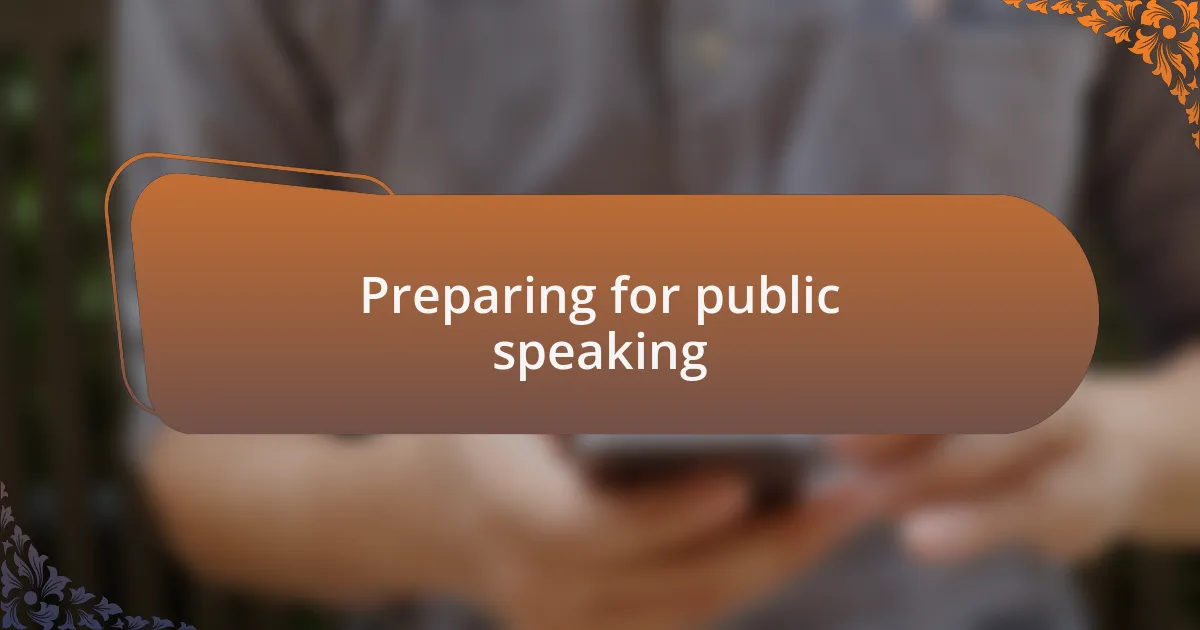
Preparing for public speaking
Preparing for public speaking often starts with understanding the material inside and out. I’ve found that thorough preparation not only boosts my confidence but also helps ease the fear of forgetting what to say. During one presentation on a topic I was passionate about, I memorized key points but also embraced the comfort of knowing I could speak naturally if needed.
Another essential aspect of preparation is rehearsing in a setting that mimics the actual environment. The first time I practiced in front of friends, I was surprised by how different it felt. Suddenly, those familiar faces became supportive allies, helping to alleviate the pressure I usually felt when imagining an audience. Isn’t it amazing how familiar surroundings can shift your perspective?
Finally, I believe that visual aids can be incredibly beneficial during public speaking. When I incorporated slides into my presentations, I noticed that they served as both a guide and a distraction from my anxiety. I remember one instance when I confidently pointed to a graph that illustrated my main point; in that moment, I felt the audience’s focus shift from me to the content, which was a huge relief. What tools will you use to make your presentation more effective?
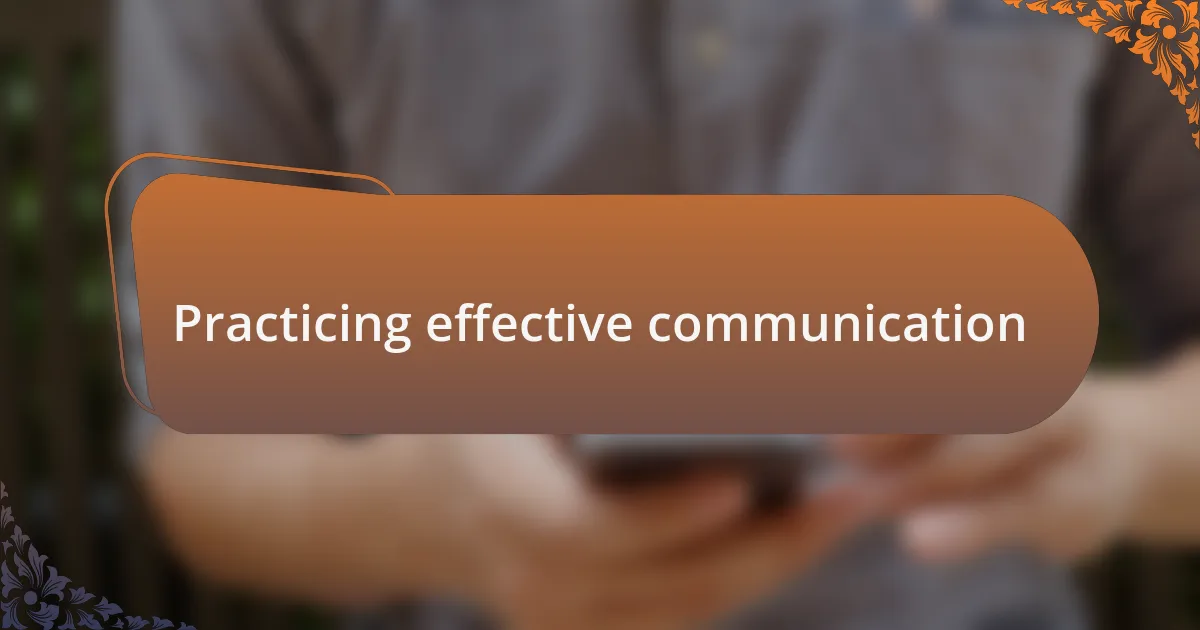
Practicing effective communication
When practicing effective communication, clarity is key. I remember once delivering a speech where I got too caught up in jargon that made sense to me but lost my audience. It was a humbling experience, reinforcing how crucial it is to speak in a way that resonates with listeners. Have you ever felt disconnected when someone uses language that’s too technical?
Active listening also plays a vital role in effective communication. During a workshop, I focused not just on what I was saying but how my audience was reacting. I noticed when I paused to invite their input, the dialogue felt more natural, and my anxiety decreased. Don’t you find that engaging with the audience helps create a sense of connection?
Lastly, body language shouldn’t be overlooked. In my early public speaking experiences, I often stood rigidly, which projected my nervousness. It wasn’t until a mentor advised me to use open gestures and maintain eye contact that I truly transformed my delivery. How has your body language influenced your interactions?
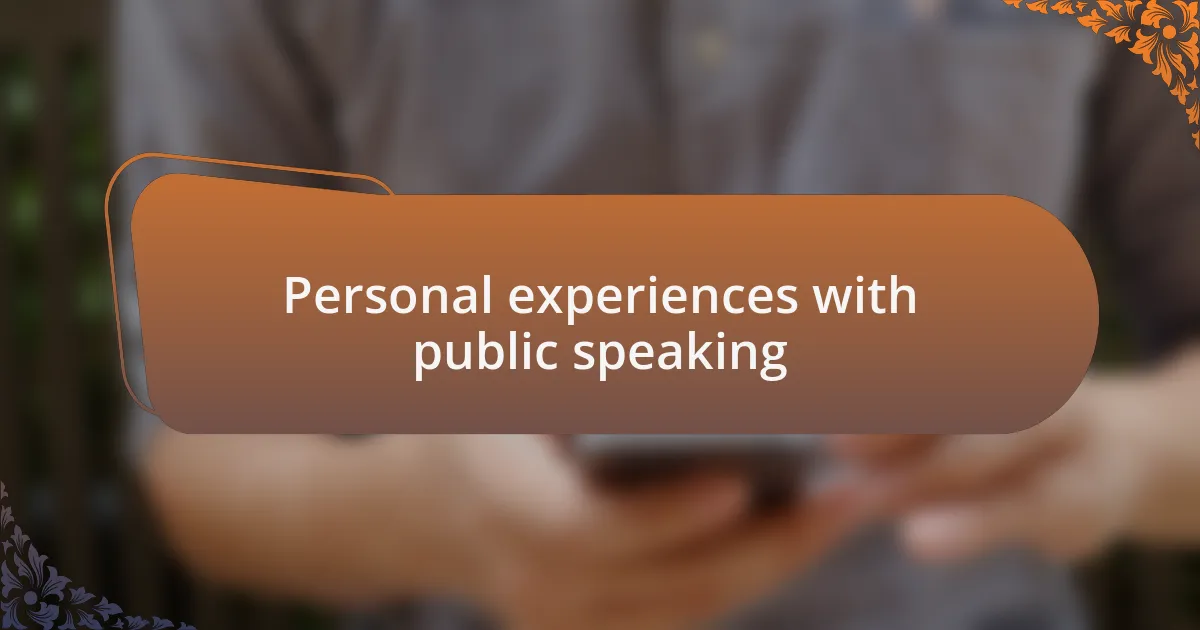
Personal experiences with public speaking
Public speaking has always been a challenging experience for me. I vividly recall the first time I stood in front of an audience, my heart racing and palms sweating. I still get a little uneasy, but I recognize that each experience teaches me something about myself and my fears. Have you felt that wave of anxiety wash over you in a similar situation?
There was one occasion that stands out vividly. I was tasked with presenting a project to a group of professionals. As I began, I stumbled over my words and could see the confused expressions in the room. It made me realize, in that moment, the importance of preparation and believing in my message. How do you handle setbacks in public speaking?
Now, I view public speaking as a chance to connect, rather than a burden. I’ve discovered breathing techniques that help ground me before I step onto the stage. Allowing myself to visualize the audience as supportive rather than critical has transformed my perspective. What tricks do you employ to manage your nerves when speaking in front of others?